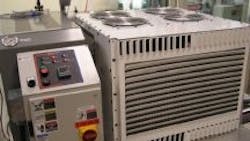Microchannels, organic rankine cycle combine to recycle waste heat efficiently
Clever ideas for recycling waste heat are starting to get headlines these days as industry increasingly recognizes how much energy goes up smokestacks. One of the latest ideas comes from Oregon State University and employs an organic rankine cycle engine combined with a special microchannel heat exchanger. Researchers there devised a prototype that turned 80% of every kilowatt of waste heat into a kilowatt of cooling capability.
The working principle of the organic Rankine cycle is the same as that of the Rankine cycle: The working fluid is pumped to a boiler where it is evaporated, passes through a turbine and is finally re-condensed.
The working fluid is HFC-245fa refrigerant and is used partly because it must have a boiling temperature lower than that of water.
The first step in the process vaporizes the working fluid in a boiler. The superheated vapor then flows through ascroll expander to produce shaft work. The vapor then enters a recuperator to preheat the fluid going to the boiler. Researchers say this internal heat recuperation is important for improving cycle efficiency because it reduces the amount of heat at the boiler and boosts the average heat input temperature.
The vapor then enters a power condenser to reject heat to the environment. The slightly subcooled fluid flows into a reservoir and then to a pump which boosts the pressure. The exiting high-pressure fluid goes through the recuperator and enters the boiler to complete the cycle.
The cooling side is based on a standard vapor compression cycle. Instead of using an electric motor to drive the compressor, researchers modified a refrigeration scroll compressor to directly couple with the scroll expander through a common shaft. This eliminates the conversion losses associated with an electrical generator and motor, typically 20 to 40%. The high-pressure vapor after compression goes through the standard condensing and evaporating processes before completing the loop.
Researchers used hot oil at up to 200 °C as a simulated heat source. The microchannel heat exchangers helped keep the system small and compact. Researchers compared their performance to two conventional plate heat exchangers for the boiler and recuperator and found the integrated microchannel boiler/recuperator had significantly better heat transfer over a range of mass flow rates
The actual heat transfer effectiveness for the recuperator was significantly higher than the designed value of 85%. Researchers say with the integrated microchannel boiler/recuperator, the thermally activated cooling system realized over 5 kW of cooling and approached an overall COP (coefficient of performance) of 0.8 under laboratory conditions.
You can see the full OSU report here: http://ir.library.oregonstate.edu/xmlui/bitstream/handle/1957/21679/Thermally%20Activated%20Cooling%20Systems%20Using%20Microchannel%20HXs_ATE_final%5B2%5D.pdf?sequence=1
